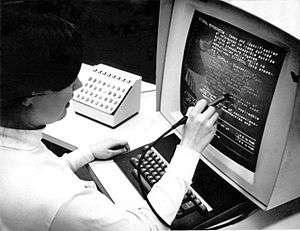Light pen

A light pen is a computer input device in the form of a light-sensitive wand used in conjunction with a computer's CRT display.
It allows the user to point to displayed objects or draw on the screen in a similar way to a touchscreen but with greater positional accuracy. A light pen can work with any CRT-based display, but its ability to be used with LCDs was unclear (though Toshiba and Hitachi displayed a similar idea at the "Display 2006" show in Japan[1]).
A light pen detects changes of brightness of nearby screen pixels when scanned by cathode ray tube electron beam and communicates the timing of this event to the computer. Since a CRT scans the entire screen one pixel at a time, the computer can keep track of the expected time of scanning various locations on screen by the beam and infer the pen's position from the latest timestamp.
History
The first light pen was created around 1955 as part of the Whirlwind project at MIT.[2][3]
During the 1960s light pens were common on graphics terminals such as the IBM 2250, and were also available for the IBM 3270 text-only terminal.
Light pen usage was expanded in the early 1980s to music workstations such as the Fairlight CMI and personal computers such as the BBC Micro. IBM PC compatible CGA, HGC and some EGA graphics cards also featured a connector compatible with a light pen, as did early Tandy 1000 computers,[notes 1] the Thomson MO5 computer family, the Atari 8-bit, Commodore 8-bit and Amstrad PCW home computers.
Because the user was required to hold their arm in front of the screen for long periods of time (potentially causing "gorilla arm") or to use a desk that tilts the monitor, the light pen fell out of use as a general purpose input device.
See also
Notes
- ↑ For example, the Tandy 1000 SX has a DE-9 light pen conector on the rear panel; on the later-introduced Tandy 1000 TX, this light pen interface has been replaced with a serial port using the same connector in the same location.
References
- ↑ "Slashphone Article". 2006-04-20. Archived from the original on 2008-11-20. Retrieved 2008-11-12.
- ↑ "A Critical History of Computer Graphics and Animation". Retrieved 2009-05-04.
- ↑ "The Computer Desktop Encyclopedia (entry for Light Pen)". Retrieved 2009-05-04.
| Wikimedia Commons has media related to Light pens. |